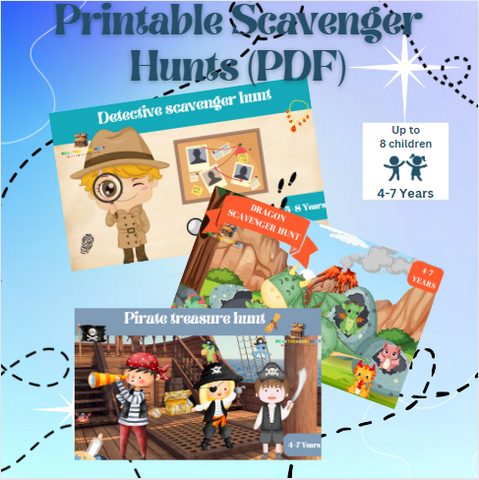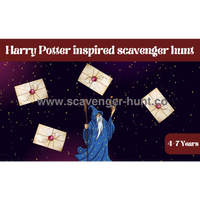A photo scavenger hunt can be more entertaining than a traditional scavenger hunt for several reasons:
-
Creativity: Participants have to think creatively to capture photos of the items on the list. This adds an extra dimension to the game as they not only have to find the items but also think about how to compose an interesting photo.
-
Technology Integration: In today's digital age, most people have smartphones with cameras. A photo scavenger hunt makes use of this technology, allowing participants to easily snap and share photos of the items they find. This can make the hunt more accessible and engaging for participants of all ages.
-
Social Interaction: Participants can share their photos in real-time with each other or on social media platforms, fostering interaction and friendly competition. This can create a sense of camaraderie and excitement as participants see each other's photos and progress.
-
Memories: Unlike traditional scavenger hunts where participants only have memories of finding items, a photo scavenger hunt leaves behind a tangible record of the experience. Participants can look back on the photos they took and reminisce about the fun they had during the hunt.
-
Variety: With a photo scavenger hunt, you can include a wide variety of items on the list, ranging from simple objects to more creative challenges. This allows you to tailor the hunt to the interests and abilities of the participants, keeping them engaged and entertained throughout the game.
Overall, a photo scavenger hunt adds an extra layer of fun and excitement to the traditional scavenger hunt format, making it a more entertaining and memorable experience for participants.
Discover our Complete Scavenger Hunts Collection.

Best Photo Scavenger Hunt Ideas
1. Team Building Scavenger Hunt
A team building scavenger hunt is designed to promote teamwork, communication, and problem-solving skills among participants. Teams work together to complete challenges and find items on a predetermined list.
Tutorial:
-
Form Teams: Divide participants into teams of 3-5 members each. Encourage diversity within teams to enhance collaboration.
-
Create Challenges: Develop a list of challenges or tasks that require teamwork to complete. Include activities like building a human pyramid, creating a funny team pose in a public place, or solving riddles to find hidden clues.
-
Set Boundaries: Define the area where the scavenger hunt will take place. This could be a park, office building, or any other suitable location.
-
Distribute Lists: Provide each team with a list of challenges and a timeline for completion. Make sure to emphasize the importance of teamwork and creativity.
-
Capture Photos: Teams must use a smartphone or camera to capture photos of themselves completing each challenge. Encourage creativity and humor in the photos.
-
Review and Award: After the designated time, gather all teams together to review their photos and experiences. Award prizes for the most creative, collaborative, and funniest teams.
2. College Campus Scavenger Hunt
This scavenger hunt takes participants on a tour of their college campus while completing challenges and tasks related to campus landmarks, traditions, and history.
Tutorial:
-
Research: Create a list of campus landmarks, historical sites, and traditions that participants should visit or learn about during the scavenger hunt.
-
Develop Challenges: Design challenges and tasks that require participants to interact with campus features, such as taking a selfie with the school mascot, finding a specific building, or reciting the school alma mater.
-
Provide Instructions: Distribute the scavenger hunt list to participants, along with any additional instructions or rules.
-
Set Time Limits: Specify a time limit for completing the scavenger hunt to keep participants engaged and on schedule.
-
Review and Share: After the scavenger hunt, gather participants together to review their photos and experiences. Share interesting facts or stories about each campus landmark.
3. Conference and Trade Show Scavenger Hunt
This scavenger hunt adds an element of fun and engagement to conferences and trade shows by encouraging participants to explore the event venue, network with other attendees, and discover exhibitor booths.
Tutorial:
-
Identify Points of Interest: Determine key areas of the conference or trade show venue that participants should visit, such as speaker sessions, exhibitor booths, or networking areas.
-
Create Challenges: Develop challenges and tasks that require participants to interact with speakers, exhibitors, and other attendees. For example, participants could take a selfie with a keynote speaker or collect business cards from exhibitor booths.
-
Provide Instructions: Distribute the scavenger hunt list to participants, along with any rules or guidelines for completing the tasks.
-
Set Time Limits: Specify a time frame for completing the scavenger hunt, taking into account the duration of the conference or trade show.
-
Review and Reward: After the event, gather participants together to review their photos and experiences. Award prizes for completing the most challenges or for the most creative photos.
4. Nature Scavenger Hunt
Participants explore the great outdoors while searching for items and completing challenges related to nature, wildlife, and the environment.
Tutorial:
-
Choose Location: Select a natural area such as a park, forest, or beach for the scavenger hunt.
-
Create List: Develop a list of natural items for participants to find, such as leaves, rocks, flowers, or animal tracks. Include challenges like identifying bird calls or building a natural sculpture.
-
Provide Instructions: Distribute the scavenger hunt list to participants, along with guidelines for respectful behavior in natural spaces.
-
Set Safety Rules: Emphasize safety precautions, such as staying on designated trails and avoiding potentially hazardous plants or animals.
-
Review and Reflect: After the scavenger hunt, gather participants together to review their photos and discuss their experiences in nature. Encourage reflection on the importance of conservation and environmental stewardship.
5. Zoo Scavenger Hunt
Participants visit a zoo and complete challenges related to the animals, exhibits, and conservation efforts.
Tutorial:
-
Plan Visit: Choose a zoo with a diverse collection of animals and exhibits for the scavenger hunt.
-
Create List: Develop a list of animals and exhibits for participants to visit, along with challenges such as identifying animal species, learning about conservation efforts, or imitating animal behaviors.
-
Provide Instructions: Distribute the scavenger hunt list to participants, along with guidelines for respectful behavior towards animals and zoo staff.
-
Set Time Limits: Specify a time frame for completing the scavenger hunt to ensure participants have enough time to explore the zoo.
-
Review and Learn: After the scavenger hunt, gather participants together to review their photos and share interesting facts or stories about the animals and exhibits they visited.
6. Classroom Scavenger Hunt
Students explore their classroom or school while completing challenges and tasks related to learning objectives or educational themes.
Tutorial:
-
Define Objectives: Determine learning objectives or educational themes for the scavenger hunt, such as historical events, scientific concepts, or literary works.
-
Create List: Develop a list of items, questions, or tasks for students to complete, incorporating educational content relevant to the classroom or curriculum.
-
Provide Instructions: Distribute the scavenger hunt list to students, along with any guidelines or rules for completing the tasks.
-
Facilitate Exploration: Allow students to explore the classroom or school environment while working individually or in teams to complete the scavenger hunt.
-
Review and Discuss: After the scavenger hunt, gather students together to review their findings and discuss the educational content covered during the activity.
7. City Scavenger Hunt
Participants explore a city while completing challenges and tasks related to landmarks, history, culture, and local attractions.
Tutorial:
-
Choose City: Select a city with a rich history, diverse culture, and interesting landmarks for the scavenger hunt.
-
Create List: Develop a list of landmarks, historical sites, cultural attractions, and local businesses for participants to visit, along with challenges such as taking photos, answering trivia questions, or interacting with locals.
-
Provide Instructions: Distribute the scavenger hunt list to participants, along with guidelines for respectful behavior in public spaces and towards local residents.
-
Set Time Limits: Specify a time frame for completing the scavenger hunt, taking into account the size of the city and the number of locations to visit.
-
Review and Explore: After the scavenger hunt, gather participants together to review their photos and share interesting facts or stories about the city's history, culture, and attractions.
Discover our Complete Scavenger Hunts Collection.

How to Create the Best Photo Scavenger Hunt
Creating the best photo scavenger hunt involves careful planning, creativity, and attention to detail. Here's a step-by-step guide to help you organize an exciting and memorable scavenger hunt:
Step 1: Define the Purpose and Theme
- Determine the purpose of the scavenger hunt (e.g., team building, educational, recreational).
- Choose a theme that aligns with the purpose and interests of participants (e.g., nature, urban exploration, historical landmarks).
Step 2: Set Objectives and Goals
- Establish clear objectives and goals for the scavenger hunt, such as fostering teamwork, exploring a specific area, or learning about a particular topic.
Step 3: Plan the Scavenger Hunt Route
- Select a location or area where the scavenger hunt will take place, considering factors such as accessibility, safety, and the availability of interesting landmarks or items.
- Determine the boundaries and specific areas participants should explore during the scavenger hunt.
Step 4: Develop a List of Challenges and Tasks
- Create a list of challenges, tasks, or items that participants must complete or find during the scavenger hunt.
- Include a variety of challenges that cater to different interests and abilities, such as trivia questions, physical tasks, and creative photo opportunities.
- Ensure that challenges are relevant to the theme and objectives of the scavenger hunt.
Step 5: Prepare Materials and Resources
- Gather any materials or resources needed for the scavenger hunt, such as maps, clue cards, or props.
- If necessary, obtain permission or permits for accessing certain locations or landmarks.
Step 6: Design Scorecards or Checklists
- Create scorecards, checklists, or scavenger hunt apps to track participants' progress and completion of challenges.
- Provide clear instructions and guidelines for how participants should document their activities and collect evidence (e.g., photos, videos).
Step 7: Determine Team Structure and Size
- Decide whether participants will compete individually or in teams, and establish the size of each team.
- Consider factors such as the number of participants, the complexity of challenges, and the desired level of interaction and collaboration.
Step 8: Set Rules and Guidelines
- Establish rules and guidelines for participating in the scavenger hunt, covering aspects such as safety, respectful behavior, and time limits.
- Communicate the rules clearly to all participants before the scavenger hunt begins.
Step 9: Promote and Invite Participants
- Create promotional materials or invitations to generate interest and excitement among potential participants.
- Use social media, email, or other communication channels to invite participants and provide them with relevant information about the scavenger hunt.
Step 10: Facilitate the Scavenger Hunt
- Brief participants on the rules, objectives, and logistics of the scavenger hunt before starting.
- Provide participants with any necessary materials, such as maps, clue cards, or scorecards.
- Monitor the progress of participants throughout the scavenger hunt and offer assistance or guidance as needed.
- Encourage teamwork, creativity, and engagement among participants.
Step 11: Review and Award
- Gather participants together after the scavenger hunt to review their photos, experiences, and accomplishments.
- Evaluate participants' performance based on the completion of challenges, creativity, and adherence to rules.
- Award prizes or recognition to individuals or teams that demonstrate outstanding achievement or effort during the scavenger hunt.
Step 12: Reflect and Follow Up
- Facilitate a debriefing session to discuss participants' experiences, insights, and feedback about the scavenger hunt.
- Reflect on the success of the event and identify areas for improvement or future opportunities.
- Follow up with participants to thank them for their participation and share highlights or memories from the scavenger hunt.
By following these steps, you can create a fun, engaging, and memorable photo scavenger hunt that participants will enjoy and remember for years to come.
Discover our Complete Scavenger Hunts Collection.

Want More? Here Are a Few Examples
-
Funny Faces: This challenge is all about letting loose and having fun! Gather your team members in a public place and encourage them to make the silliest, most exaggerated faces they can imagine. Whether it's crossing their eyes, sticking out their tongues, or contorting their features in amusing ways, the goal is to capture the spirit of playful spontaneity in your photos. Bonus points for incorporating unexpected props or surroundings to enhance the comedic effect!
-
Puzzle Piece: The world is filled with fascinating patterns and designs waiting to be discovered, and this challenge encourages you to seek out one that resembles a puzzle piece. Look for intricate patterns in architecture, nature, or everyday objects that evoke the shape or texture of a puzzle piece. Whether it's the interlocking lines of a cobblestone street, the geometric tiles of a mosaic, or the swirls of a seashell, capturing an image that resembles a puzzle piece will test your observational skills and creativity.
-
Shadow Play: Shadows can transform ordinary scenes into works of art, and this challenge invites you to explore the captivating interplay of light and shadow. Find a suitable backdrop—a blank wall, a sunlit sidewalk, or any surface that catches the light—and position your team members to create interesting shadow shapes with their bodies. Experiment with different poses, angles, and distances to achieve striking silhouettes and compositions. Whether you're mimicking iconic shapes or inventing your own shadow characters, this challenge encourages imagination and experimentation.
-
Reflections: Reflections offer a fascinating glimpse into parallel worlds, and this challenge invites you to explore the mesmerizing effects of reflective surfaces. Search for mirrors, windows, water bodies, or any other reflective surfaces that can capture intriguing reflections of your team members. Experiment with angles, perspectives, and compositions to create visually striking images that play with symmetry, distortion, and abstraction. Whether you're capturing distorted funhouse reflections or serene mirror images, this challenge celebrates the beauty of reflection in all its forms.
-
Nature's Art: Nature is the ultimate artist, and this challenge encourages you to uncover its hidden masterpieces. Venture into the great outdoors and seek out natural objects that resemble works of art, from intricately patterned leaves and colorful flowers to sculptural rock formations and textured tree bark. Whether you're marveling at the delicate symmetry of a snowflake or the vibrant hues of a sunset, capturing the artistry of nature in your photos will inspire awe and appreciation for the wonders of the natural world.
-
Urban Wildlife: Cities may seem like concrete jungles, but they're also home to a surprising variety of wildlife. This challenge invites you to look beyond the hustle and bustle of urban life and discover the creatures that share our urban spaces. Keep your eyes peeled for unexpected animal encounters, from squirrels darting across parks to birds perched on city rooftops. Whether you're capturing a curious raccoon exploring a trash can or a colorful butterfly fluttering amidst skyscrapers, this challenge celebrates the resilience and adaptability of urban wildlife.
-
Miniature World: Perspective is everything in this whimsical challenge that plays with scale and perception. Find small objects or scenes that, when photographed from a specific angle, appear larger than life. Whether you're posing with tiny figurines to create the illusion of giants or arranging everyday objects to resemble oversized props, this challenge encourages you to embrace your imagination and experiment with perspective. From towering toy buildings to monumental miniatures, the possibilities are endless in this enchanting miniature world.
-
Street Art: Street art adds vibrancy and character to urban landscapes, and this challenge invites you to explore the vibrant world of graffiti, murals, and public art. Venture into city streets and alleys in search of colorful and captivating artworks that reflect the creativity and diversity of urban culture. Whether you're admiring larger-than-life murals that tell stories of community and activism or stumbling upon hidden gems of street art tucked away in unexpected corners, this challenge celebrates the power of art to transform public spaces and inspire imagination.
-
Symmetry: Symmetry is a fundamental principle of beauty and balance, and this challenge invites you to seek out symmetrical scenes and compositions in the world around you. Look for natural or man-made elements that exhibit perfect symmetry, whether it's the reflection of a bridge in a calm river, the mirrored wings of a butterfly, or the repeating patterns of a kaleidoscope. Experiment with framing, angles, and compositions to capture images that showcase the harmony and elegance of symmetry in all its forms.
-
Color Explosion: Colors have the power to evoke emotions, spark creativity, and transform our surroundings, and this challenge celebrates the vibrant palette of the world around us. Seek out scenes bursting with color, from dazzling sunsets and blooming flower gardens to bustling marketplaces and colorful street art. Whether you're capturing the rich hues of a rainbow after a summer shower or the vivid hues of a bustling cityscape, this challenge invites you to revel in the kaleidoscope of colors that surrounds us every day.
Discover our Complete Scavenger Hunts Collection.













































